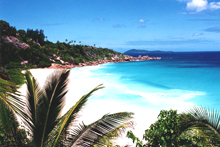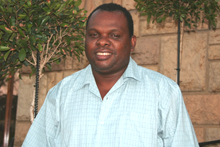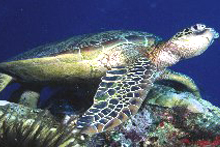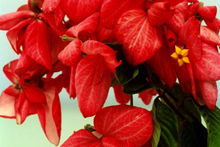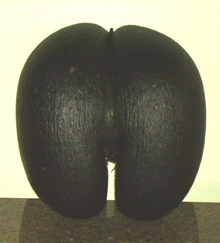Safeguarding the natural beauty of Seychelles
Didier Dogley, Director-General of Nature Conservation in Seychelles, flew in to attend the ELTOSA AGM and ILTER Conference in Namibia. SAEON e-News caught up with him in transit to Namibia.
Didier Dogley is a man with a mission... to protect the natural environment of the islands thought to be among the most beautiful on Earth - the Seychelles, situated about 1 600 km off the East Coast of Africa.
With 115 unspoilt tropical islands scattered over a million square kilometres in the western Indian Ocean, Seychelles has remained very much as it was at the dawn of time. Magnificent granite boulders frame coral-coloured beaches surrounded by turquoise seas. But the ancient archipelago's granitic islands are not only among the most beautiful on Earth, they are also the oldest oceanic islands on Earth.
Sanctuary for some of the planet's rarest species
Seychelles is a sanctuary for some of the world's rarest species of flora and fauna."Nowhere else will you find unique endemic specimens such as the Coco-de-Mer, the largest seed in the world, the jellyfish tree, one of the rarest trees on this planet, with only eight surviving examples, the Seychelles' paradise flycatcher and Seychelles warbler," says Didier proudly.
|
Seychelles nurtures an amazing array of endemic species ranging from the smallest frog to the heaviest land tortoise and the only flightless bird of the Indian Ocean. Rare endemic plants found nowhere else in the world adorn Mahé Island's mist forests in mountain strongholds, such as the jellyfish tree, the carnivorous Seychelles pitcher plant and the Seychelles vanilla orchid.
The jellyfish tree was thought to be extinct until a few of them were discovered in the 1970s. The stamen of the flower resembles the tentacles of a jellyfish, hence the common name of the plant.
The unique biogeographic situation of the Seychelles, which is situated on a migration route linking two continents and an island of continental dimensions (Madagascar) has shaped its extraordinary avifauna.
The islands are home to some of the rarest endemic birds to be found on Earth, including the Seychelles bush warbler, paradise flycatcher, and bare-legged scops owl. Mahé's rarest bird, the bare-legged scops owl is so rare that it was once thought to have become extinct before being re-discovered in 1959.
"Almost 50% of the landmass has been set aside as national parks and reserves," says Didier,"and we are proud of our conservation policies that have resulted in a significant degree of protection for the environment and the biodiversity it supports."
The rich marine life of the Seychelles is conserved in six marine national parks: Sainte Anne, Silhouette, Baie Ternay, Ile Cocos, and Curieuse. The Sainte Anne Marine National Park, founded in 1973, was the first marine park in the Indian Ocean.
UNESCO World Heritage Sites
Seychelles is also home to two UNESCO World Heritage Sites: Aldabra, the world's largest raised coral atoll and Praslin's Vallée de Mai, once believed to be the original site of the Garden of Eden.
Aldabra was designated a World Heritage Site by UNESCO in 1982 as a prime example of a raised coral atoll and is significantly less disturbed than most other atolls in the Indian Ocean and elsewhere in the world.
Vallée de Mai was designated a World Heritage Site by UNESCO in 1983 as an outstanding example of low- and intermediate-altitude palm forest characteristic of the Seychelles.
Aldabra and Vallee de Mai are both unique, and represent the rich natural heritage of Seychelles. These sites conserve:
- The world's largest raised coral atoll
- The world's largest giant tortoise population
- Some of the world's most spectacular seabird colonies
- The largest intact Coco-de-Mer forest and many other endemic trees, plants and animals
- Rare birds, including the last surviving flightless bird of the Indian Ocean, the Aldabra rail, and the endangered Seychelles Black Parrot
But Paradise has its problems too
Didier describes his work as Director-General of Nature Conservation in the Seychelles as"wonderful, but definitely not easy". Nowadays there is a lot of development on the islands, he says, especially hotels and resorts, and that makes patrolling and monitoring much more complicated.
"There is a lot of pressure," Didier explains,"especially from an economic point of view, to bring in more revenue and boost the economy, so there's always more hotels and more development. And even though the development takes place outside of ecologically sensitive areas, with the islands being so small, anything you do will inevitably impact on the environment."
"My work largely involves preserving the delicate balance between economic progress and the protection of the environment," he says."On the one hand I have to deal with public outcry against any new development on the island, while on the other hand there are those people pushing for development."
With the Seychelles being so small, insufficient resources, and human resources in particular, is a major obstacle."We need more people to do research, patrol the area and do regular monitoring," he explains. It is impossible to monitor all 115 islands of the Seychelles, even though the hotels often assist the rangers.
One intervention has been to bring in students and researchers from other countries, but this needs to be properly coordinated and managed. Students mostly come in to do a MSc or PhD, so research is mostly short-term."We need long-term monitoring and research done in the Seychelles," says Didier,"that's why ELTOSA is so important to us."
|
Another problem they've encountered is that the researchers tend to be very protective of the data they collect."There's still a lot of reluctance to share data," he admits."We've been trying to make the researchers understand that if we don't give them access to the different organisms or the environment in the first place they won't be able to do the research. So there must be a compromise. To me it's a little bit like patents. Somebody would do research, invest money and resources to develop a certain body of knowledge, and once that has been done, you get a patent for a limited period of time, so that you can enjoy the benefits of your research. But once the patent period has lapsed, the information has got to be in the public domain."
Didier says that they have a lot to learn from SAEON in terms of data management. SAEON is currently working on an ethic for data sharing."I think the sharing of data and information is going to be very challenging, but very important for the future. I would be very interested in getting a policy or protocol in place for data sharing."
Areas that need special attention
Didier points out that the marine environment has become extremely vulnerable over the past eight years on account of coral bleaching. About 90% of the coral around the islands died in 1998 due to a rise in water temperature caused by El Niño. The water temperature rose by 3 degrees and maintained that temperature for about two weeks. This proved fatal for the coral."With global warming we don't foresee that the situation can be turned around," says Didier."The water temperature around the islands has been rising steadily since 1998. And then you still find people who say that global warming is a myth," he says with an incredulous shake of his head.
Another major challenge is that fish numbers around the coral have also declined."There's not much we can do about it," says Didier,"except to try and keep the environment as clean and stress-free as possible. We want to ensure that the coral has the best possible conditions to allow them to recover, so we try to reduce all stress factors, such as pollution, to the lowest point."
"Seychelles is proud of its conservation policies to ensure protection of fish stocks," says Didier."One example of this is a total ban on the use of spear guns throughout Seychelles' waters. Local customs officials will confiscate such items from anyone who carries them when entering Seychelles."
Fishing is prohibited within the boundaries of the Curieuse, Ile Cocos, Port Launay/Baie Ternay and Ste. Anne Marine National Parks. These areas are patrolled by park rangers, and no fishing is permitted within 200 metres around Aride Island Nature Reserve.
"The practice of 'tag and release' has been widely adopted in order to safeguard fish stocks for future generations of fishermen," explains Didier."The gentle whale shark, for example, which is common in our waters during the month of August and from October to January, is a species protected both by Seychelles law and by CITES, the Convention on International Trade in Endangered Species."
According to Didier the penalties of some of their environmental laws are quite harsh. Unfortunately some of the laws are quite dated (dating back 30 to 35 years), and they're currently in the process of updating the entire legal system as well as the penalties.
Terrestrially, one of the main challenges for National Parks is the conservation of the Coco-de-Mer (Lodoicea maldivica), a palm endemic to the islands of Praslin and Curieuse in the Seychelles. It formerly also occurred on St Pierre, Chauve-Souris and Round Islands in the Seychelles group, but has become extinct on these islands.
The palm, which grows 25 to 34 metres tall, produces the largest seed in the world, weighing anything from 15 to 30 kg. The fruit requires 6 to 7 years to mature and a further two years to germinate.
The Coco-de-Mer seed was once thought to originate from a mythical tree growing beneath the ocean, and fetched princely sums in the courts of Europe. European nobles in the sixteenth century would often have the shells of these nuts cleaned and decorated with valuable jewels as collectibles for their private galleries. The sailors who first saw the nut floating in the sea imagined that it resembled a woman's buttocks. Still much sought after by tourists, almost every single nut is currently collected and sold to tourists, so there's no regeneration in the wild.
With its status listed as vulnerable, the Coco-de-Mer is now a rare protected species."How do you sustainably collect these fruits without putting the population into danger?" asks Didier."The population is declining quite rapidly, so we needed to have a replanting programme. Subsidiary populations have been established on Mahé and Silhouette Islands in the Seychelles to help conserve the species."
Seychelles hosts globally important populations of marine turtles, including one of the five largest nesting populations of the critically endangered Hawksbill Turtle remaining in the world. There are also significant nesting populations of the endangered Green Turtle. Although the turtles are found all over the Seychelles, they tend to concentrate in the south, where there are small coral islands.
Didier mentions two studies that are underway to evaluate possible effects of climate change on aspects of sea turtle foraging and breeding biology. The first will focus on developing a strategic approach to turtle management in Seychelles. It aims to bring together stakeholders that manage and monitor turtle rookeries, find a means for them to share their data, establish a common database and then use this to develop a strategy and action plan for turtle management in Seychelles.
The second, in partnership with one of the resorts, is aimed at Integrated Marine Turtle and Beach Management, and will focus on the management of the beach, dune structure and associated vegetation to enhance turtle nesting and mitigate the impacts of tourism activities on the beach and dunes. Besides monitoring activities, the project will incorporate local community involvement, particularly through educational activities for school children. The project will further incorporate the hotel clients with educational talks, provision of information in the rooms on turtles and in particular information on how tourists should act if they encounter a turtle on the beach.
|
Both projects are funded by the British Foreign and Commonwealth Office, and both will work towards developing a strategic approach to turtle management in Seychelles."There is now a national network on all the islands," says Didier."All the data is fed into one network and we are attempting to consolidate the data."
Seychelles hosts one of the five most important regional populations of hawksbill turtles remaining in the world today, although these are much reduced in number from historic levels. Satellite transmitters attached to each of five post-nesting hawksbill turtles at Cousin Island showed their foraging habitats to be within the boundaries of the Seychelles Bank, providing evidence that female hawksbills nesting in the granitic soils of the Seychelles may spend their entire adult lives within the territorial waters of Seychelles."This provides incentives for Seychellois to protect the resource," Didier explains.
Turtle meat is a popular delicacy, and people used to harvest turtles for their meat and for their shells. But populations have dwindled."We now have very harsh laws in place," warns Didier,"and there are regular patrols to make sure that turtles are not poached - not for their meat and not for their shells. We've banned the sale of turtle shells. You can't buy turtle shells in the Seychelles.
The Seychelles Government has also repeatedly demonstrated its commitment to conserving the critically endangered hawksbill turtle: in 1993-1994, through an artisan compensation and re-training programme that eliminated domestic trade in hawksbill shell; in 1994, by providing complete legal protection for all sea turtles; and in 1998 by publicly burning its stockpile of raw hawksbill shell.
On the positive side
Fortunately the politicians of Seychelles have been very understanding of the need to preserve their natural heritage, and they support the conservation efforts in whichever way they can."There's a huge awareness of the benefits of environmental conservation and protection within the Seychelles among learners, the general public and the politicians," says Didier.
"There's been a lot of investment in environmental education during the last 16 to17 years, and even at school the learners run wildlife clubs that engage in a variety of projects. So from a very young age the children are made aware of the importance of the environment. They are fully aware that the tourism industry for one depends on a good, clean and enjoyable environment."
"The Seychelles has been unique in the way we have looked after the environment," he explains."I think we've been lucky in that people realised very early on that we don't have diamonds and gold and other minerals like Africa does, but what we have is the beauty of the islands. And that could last much longer than the minerals if we looked after it properly. So from very early on we realised that we needed to preserve the unspoilt environment for our own benefit. That is exciting. And people understand why we need to conserve the islands."
Assistance has also been received from national and international wildlife conservation institutes and bodies, which have proved to be invaluable partners in conservation, monitoring and education outreach. Some of the hotels and resorts on the islands have also proved their worth as unlikely yet staunch allies in conservation and monitoring.
Seychelles have had some of the best success stories in the world with regard to the conservation of wild birds. "Tremendous work has been done by Nature Seychelles and Birdlife International, and quite a few hotels and resorts have assisted with funds to translocate birds, establish populations and eradicate rats on the islands.
"Tourism has indeed worked positively towards conservation as far as birdlife is concerned," smiles Didier. The hotels were prepared to put quite a lot of money towards the rehabilitation of the vegetation, bringing in indigenous flora so that the birds were able to survive and establish new populations. Nearly twice as many species (250) were recorded in the Seychelles this year as compared to 1974.
Didier describes most of their tourist - many of them from Europe - as "environmentally caring". "In fact, there is sometimes an altercation between the tourists and the local fishermen," he says with a smile, "particularly when tourists break traps to release the fish caught in them. But these traps are used by the locals for their traditional, low-impact fishing. The sophisticated Europeans don't understand that these local people cannot pop into supermarkets to buy fish...!"
Seychelles and ELTOSA
Didier first learnt about ELTOSA two years ago when he attended a meeting in Botswana and met Joh Henschel of the Gobabeb Training and Research Centre in Namibia. Joh sent him some information about ELTOSA to enable him to make an informed decision about membership for the Seychelles.
Didier is excited about the possibility of Seychelles becoming a member of ELTOSA, firstly to enable them to monitor and benchmark their long-term observation strategies, techniques and information management systems, but also to build capacity in long-term environmental observation."If one is involved in science it is always good to know what the other scientists in the field are doing," he says."I regard ELTOSA as an initiative with great potential, which will increasingly attract participation from the main players in environmental observation. There is a lot of potential to develop research capacity for environmental issues in the region."
Despite the fact that the people in his conservation and observation networks are scattered across the islands, Didier has already informed most of them about ELTOSA. As the main champion of ELTOSA on the islands, he is trying to get as many people as possible, particularly in the NGOs, to participate in the network. He's already had discussions with four NGOs, some in the marine environment, and some dealing with terrestrial issues.
"Although many of them have heard about ELTOSA, they need to understand the benefits before they will start engaging," he says."The next step will be to get the people involved in the different ELTOSA programmes."
"My expectation of this meeting is that I hope it will equip me with the necessary information to go back to the Seychelles and spell out the benefits of participation to my colleagues and associates," he says.
When SAEON e-News contacted Didier after the ELTOSA meeting and ILTER conference, he described both as"worthwhile", and the discussions as"enriching".
He concluded:"I had a great time at the meeting in Gobabeb. I did not know that the desert could be such a beautiful place. The participants were also a great bunch of people. Not at all the type of grumpy scientists one used to know..."


